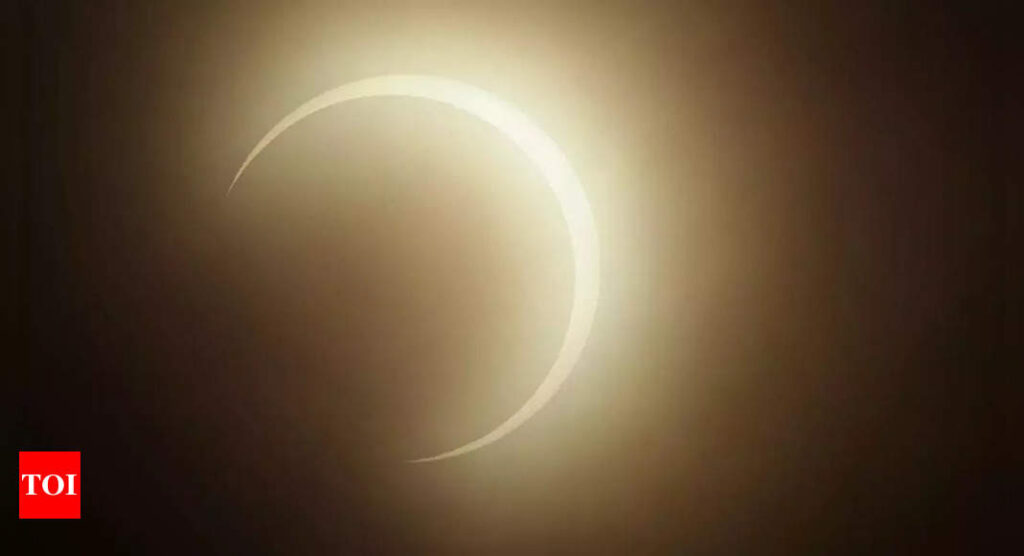[ad_1]
This event traced a path through eight US states before continuing its journey over Mexico, Guatemala, Belize, Honduras, Nicaragua, Costa Rica, Panama, Colombia, and Brazil, offering millions of people a glimpse annual occurence.
Read Also
A partial solar eclipse, the first stage of a “ring of fire” eclipse, began on Saturday morning, visible across parts of the Americas. The eclipse, also known as an annular solar eclipse, was seen in Oregon, Nevada, Utah, New Mexico, and Texas, as well as parts of California, Arizona, and Colorado.
Brett Tingley, editor at Space.com, observed the solar eclipse from Great Basin National Park in Nevada. Owing to an expedition organized by Travel Nevada, Tingley was in a favourable spot to witness the celestial phenomenon.
Initially, cloud cover threatened to obscure the view, causing some anxiety among onlookers. However, the skies gradually cleared, and about 30 minutes into the eclipse, the sun and moon emerged once again, much to the relief of the crowd at Great Basin National Park.
“As the clouds begin to part, the crowds here at Great Basin National Park let out audible sighs of relief as the sun and the moon emerged back into view some 30 minutes after the eclipse began,” Tingley said.
Tingley managed to seize the precise instant of annularity when the moon created a slender ring of sunlight on its periphery. He also recorded the eclipse’s partial phases using a Unistellar eQuinox 2 telescope fitted with a solar filter.
He then posted on X (formerly Twitter) hie experince by saying, “Just incredible”.
The eclipse was also potentially visible to millions of spectators across the United States, Central America, and South America. A partial solar eclipse was visible across much of the Americas, provided the weather cooperated. The path of annularity, spanning 125 miles, passed through parts of Oregon, Utah, Nevada, Idaho, Colorado, New Mexico, Arizona, and Texas before continuing on to Mexico and several South American countries, concluding its journey in Brazil.

Partial Solar eclipse is observed in Neiva, Colombia (Reuters/Vannessa Jimenez photo)
Nasa scientists set up observation stations in Albuquerque, New Mexico, and Kerrville, Texas, to study the eclipse. In Kerrville, they enjoyed an impressive four minutes of annularity, one of the longest durations for this particular eclipse.
The National Oceanic and Atmospheric Administration’s (NOAA) GOES-East and GOES-West satellites tracked the moon’s shadow as it crossed the United States and the broader Western Hemisphere from their orbits high above Earth.
With the eclipse’s path passing over numerous major cities in the US, several communities seized the opportunity to combine eclipse-watching events with local festivals and celebrations.
A spectator named Berman, who witnessed the eclipse from this location, reported, “We got about 70% coverage of the sun, but I brought a bunch of eclipse glasses for passers-by. They were thrilled, as was I.”
Many national parks across the eclipse’s trajectory opened their doors to eclipse chasers, offering them the chance to experience a unique blend of nature and celestial phenomena.

People use welding glasses to watch the solar eclipse at the Chichen Itza archaeological zone, in Piste, Mexico (Reuters’ Lorenzo Hernandez photo)
As with any major spectator event, a wide array of eclipse-related merchandise was made available to attendees, with people flocking to purchase memorabilia from the headquarters gift store of Capitol Reef National Park in Utah, just one day before the eclipse occurred.
[ad_2]
Source link










More Stories
We can’t wait to face India in the final: Pat Cummins | Cricket News
Railways plans 3,000 additional trains in next 4-5 years to minimise number of waitlisted tickets | India News
Faridabad: Man dies after ‘falling from hotel room window’ while partying with friends